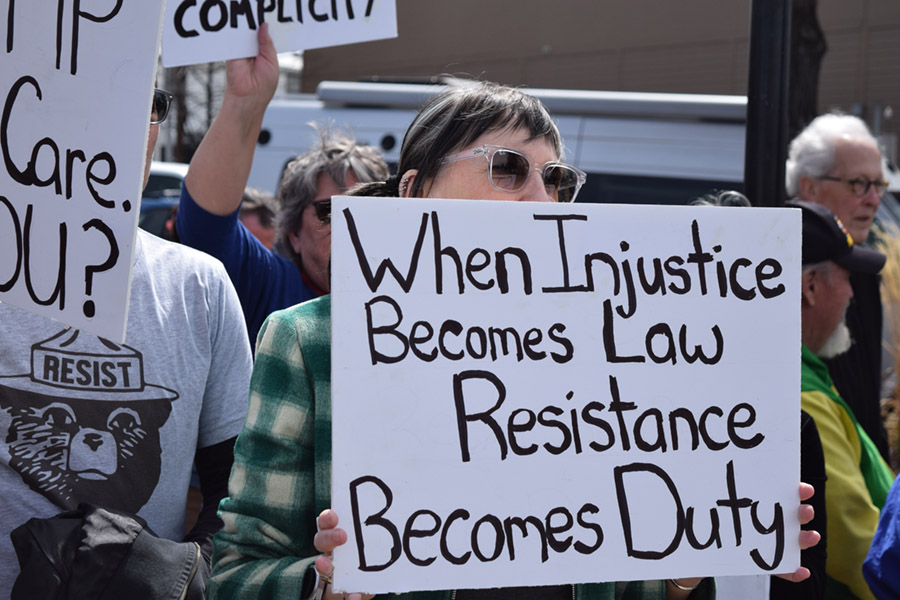As winter approaches, the challenges of commuting for students and staff become more formidable, especially for those who rely on bicycles as their mode of transportation. The harsh conditions, including snow and ice, can pose significant obstacles to a smooth and safe journey.
In a recent interview, Mathematics Professor Sean Rule speaks about his 45 minute bike commute to the Central Oregon Community College Bend campus. Rule, a commuter of three decades, provides knowledgeable insights and practical advice for students navigating the winter conditions.
The Broadside: How do you prepare for your daily commute to the college campus during the winter months? Are there any specific routines you follow?
Sean Rule: I rode three different bikes this week. I live on the northeast side of town and ride Archie Briggs every day and that’s wickedly steep and covered in ice. I start at 3,500 feet and I then climb to 4,000. It’s the bike that I have to think about. Clothing, not so much; mostly I wear the same thing the whole year. My main commuter year round is a bike I call “Gunner,” because that’s what the frame is called. It’s a single speed and I ride it from May until about now.
I actually broke the rear wheel spoke on “Gunner” riding home on Tuesday and I think that was mother nature telling me to switch over to “Josephine,” who is my surly cross bike. But since it was snowy today I didn’t want to ride her because she’s got slick tires. I could feel her sliding out on the Archie Briggs turns the other night. So today I rode my mid fat bike, it has big three inch tires so they can let some of the pressure out, and they flatten down and let you ride right on top. So the big thing for me is just which bike makes the most sense for the day.
TB: What challenges do you face when commuting in snowy or icy conditions?
SR: Drivers, and that’s not even just in snow, that’s year-round. The problem is cars are getting faster and bigger. And people are getting more and more distracted. So that’s always my biggest challenge, is cars not paying attention.
TB: Are there any essential items or gear you find particularly helpful during winter commutes?
SR: A good helmet and light. One of the best investments I’ve made for bike commuting is putting a green blinky light on your helmet, just like you have to have a red light on the back of your bike. It’s incredible how that gets the car’s attention and gets them away from you.
TB: How do you plan your commute schedule during the winter? Are there adjustments you make to accommodate potential delays or difficulties caused by weather conditions?
SR: Because I’ve been doing this for 30 years, I know that getting here when it’s clear takes me 35 minutes, and getting home takes me 20. It took me 47 minutes this morning because it was just slower and icier. I have an 8:00 a.m. class on Tuesday and Thursday, and normally I’ll leave my house at 6:30 when the roads are good, but it’s going to take me 45 minutes to get here when they’re bad so I have to kick out 10 or 15 minutes earlier those days. It’s just time. It’s not so much anything else because knock on wood, I don’t get flat tires in the winter. I usually get those in the spring. I will also often stay later at work to avoid the cars because drivers are getting more and more distracted.
TB: What advice would you give to a student who wants to start biking to campus?
SR: I would recommend finding somebody like me, who bike commutes and do a ride with them. Ride somewhere with them when there’s not a time constraint, don’t make your first ride something you have to be somewhere on time for. Be with a person who can see stuff go wrong before it goes wrong. Like that intersection is going to be there, and here’s why that hill is going to be tricky in bad weather, and here’s where I can see that when it rains, that kind of stuff, like, try riding with a commuter who’s been doing it for decades, you’ll learn all kinds of little tricks.
Two weeks ago, I was on Mount Washington coming into work. A school bus went by me and stopped and the lights came on. I stopped on the side of the road in the bike lane. The doors opened and nobody got on the bus, which was kind of weird. Then the doors closed and the bus kept going and I started going again. My spidey sense was triggered and I was like, something’s off. So I put my hand out to the cars that were behind the bus and I got right behind that bus.
As soon as I did that, the bus went into the bike lane. Something about the way the bus was moving told me it was going to end up hitting me if I didn’t get out of the way. So that’s the kind of stuff I would tell somebody new, just little advice, like assume they’re all trying to hit you. They’re not, but assume they all are. Bike defensively, ride on the left side of the bike lane when you can because the right side is where all the broken glass tends to accumulate.
Rule added, he would be willing to plan a bike ride to and from the Bend, Redmond or Madras COCC campuses with any student or staff member who wants to gain the experience and insight.
“I honestly think what keeps people from bike commuting is just not knowing what to expect, so talk to somebody who knows and make that less mysterious,” he said.




















